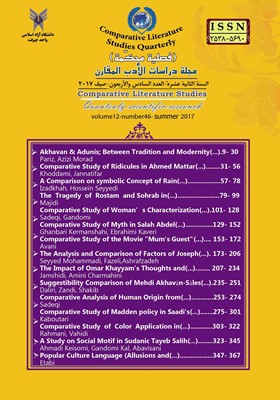A Comparison on symbolic Concept of Rain in Ahmad Shamlou and Shakir al Sayyab's Poetries
Subject Areas : شعرSara Izadkhah 1 , Seyyed Hossein Seyyedi 2
1 - MA Student, Comparative Literature, Ferdowsi University, Mashhad
2 - Full Professor, Arabic Language & Literature, Ferdowsi University, Mashhad
Keywords: rain, symbolism, symbol, احمد شاملو, Sayyab, نماد, باران, اشعار عربی و فارسی, سیاب, سمبولیسم, Persian and Arabic poetries, Ahmad Shamlou,
Abstract :
Rain in in Ahmad Shamlou and Shakir al Sayyab's Poetries is a social symbol. It contains the concepts such as sadness and happiness, hope and hopelessness. Applying Dumuzid myth in the "Rain" poetry by Sayyab and the folk language in Shamloo's verse shows the common concepts in these two poets' poetries. This paper – which is done in librarian method – tries to study "Rain" and "giant petrel" by Shamloo and "Rain song" by Sayyab to makes the availability to similar effective patterns of two poets in their poetries. The theoretical level of the research includes cause variable and the operational level shows the effect variable; by studying the poetries the frequency of the term "rain" is extracted. Finally the symbolic concepts, similarities and differences are expressed.
کتب فارسی
اسوار، موسی. 1381ش، از سرود باران تا مزامیر گل سرخ(پیشگامان شعر امروز عرب)، تهران: انتشارات سخن.
پاشایی، ع. 1378ش، نام همه شعرهای تو(زندگی و شعر احمد شاملو «ا.بامداد»)، تهران: نشر ثالث.
پورنامداریان، تقی. 1374ش، سفر در مه(تأملی در شعر احمد شاملو)، تهران: انتشارات زمستان.
شاملو، احمد. 1387ش، مجموعه آثار(دفتر یکم شعرها)، تهران: انتشارات نگاه.
شفیعی کدکنی، محمدرضا. 1385ش، این کیمیای هستی، به کوشش ولی الله درودیان، تبریز: انتشارات آیدین.
عمید، حسن. 1389ش، فرهنگ فارسی، تهران: انتشارات راه رشد.
نوری زاد، محمدحسین. 1384ش، چهار افسانه شاملو(نگاهی به چهار شعر عامیانه احمد شاملو)، تهران: نشر دنیای نو.
کتب عربی
بلاطه، عیسی. 1971م، بدر شاکر السیاب(حیاته وشعره)، بیروت: دار النهار.
توفیق، حسن. 1979م، شعر بدر شاکر السیاب(دراسة فنیة وفکریة)، بیروت: مؤسسة العربیة للدراسات والنشر.
الخبو، محمد. 1995م، مدخل إلی الشعر العربی الحدیث، تونس: دار الجنوب للنشر.
شوالیه، ژان و گربران، آلن. 1384ش، فرهنگ نمادها: اساطیر، رؤیاها، رسوم و ...، ترجمه سودابه فضایلی، تهران: انتشارات جیحون.
ضاوی، عرفات. 1389ش، کارکرد سنت در شعر معاصر عرب، ترجمه دکتر سید حسین سیدی، مشهد: انتشارات دانشگاه فردوسی مشهد.
عباس، احسان. 1992م، بدر شاکر السیاب(دراسة فی حیاته وشعره)، بیروت: المؤسسة العربیة للدراسات والنشر.
عوض، ریتا. 1978م، اسطورة الموت والانبعاث فی شعر العربی الحدیث، بیروت: المؤسسة العربیة للدراسات والنشر.
کمال زکی، احمد. 1991م، دراسات فی النقد الادبی، بیروت: دار الاندلس.
کتب لاتین
Badawi.M.M.A.criticalintroduction to Modern Arabic Poetry.Lodon.Cambridge
مقالات
سالمیان، غلامرضا و آرتا، سید محمد و حیدری، دنیا. 1391ش، «بررسی تطبیقی دلالت معنایی نمادها در ادبیات کلاسیک و اشعار شاملو»، فصلنامه زبان و ادبیات فارسی، شماره 73، پاییز، صص67-98.
سلاجقه، پروین. 1384ش، «انگارههای کهن الگویی در دو منظومه کودکانه فولکلوری از احمد شاملو»، فصلنامه فرهنگ، صص 108-119.
طهماسبی، عدنان و زارع، ناصر.1390ش، «متناقض نما در نمادهای شعر انشودة المطر»، مجله ادب عربی، شماره 3، تابستان، صص 177-197.
متحدین، ژاله. 1354ش، «تکرار، ارزش صوتی و بلاغی آن»، مجله دانشکده ادبیات و علوم انسانی مشهد، شماره3.
معروف، یحیی و ویسی، روشنک. 1391ش، «بررسی تطبیقی مفهوم نمادین باران در شعر سیاب و اخوان»، نشریه دانشکده ادبیات دانشگاه شهید باهنر کرمان، شماره7، پاییز و زمستان، صص 175-193.
ناظمیان، رضا. 1385ش، «زمینههای درک رمز و نماد در شعر معاصر عرب»، مجله زبان و ادب، شماره 29، پاییز، صص184-204.
_||_
Asarv, Moses. 2002, From Rain to Psalms of Roses (Pioneers of Arabic Poetry), Tehran: Sokhan Publications.
Pournamdarian, Taghi, 1995, Traveling in May (A Revelation in Shahr Ahmad Shamloo), Tehran: Winter Edition.
Pashaei, AS. 1999, the name of all your poems (Ahmad Shamloo's life and poem, A. A. Bamdad), Tehran: Nasrallat.
Salmiyani, Gholamreza, Arta, Seyed Mohammad, Heydari, Deniya, 2012, "Comparative Study of Semantic Implications of Symbols in Classical Literature and Shamloo Poems", Farsi Language and Literature, No. 73, pp. 67-98.
Salajegheh, Parvin, 2005, "Ancient Patterns of Patterns in Two Folklore Children's Poems by Ahmad Shamloo", Culture Quarterly, Pages 108-119.
Shamloo, Ahmed, 2008, Collection of Works (Poems Worksheets), Tehran: Publishing View.
Shafiee Kadkani, Mohammad Reza, 2006, This Being Kimia (by Volayullah Doroodianj), Tabriz: Aydin Publications.
Tahmasebi, Adnan, Zare, Nasser, 2011, "Paradoxical View in the Symbols of the Poetry of the Creator", Arabic Literature, No. 3. Summer, pp. 177-197.
Amid, Hasan, 2010, Farsi Culture, Tehran: Growth Publishing
Allies, Jaleh, 1975, "Repeat, its Voice and Rigor", Journal of Faculty of Literature and Humanities of Mashhad, No. 3.
maaroof, Yahya; Vaisi, Roshanak, 2012; "A comparative study of the symbolic meaning of rain in the poem of Siavok vahvan", Shahid Bahonar University Faculty of Literature, Kerman, No. 7, Autumn and Winter, pp. 19-193.
Nazemian, Reza, 2006, "The Fields of Understanding Cipher and Symbol in Arabic Contemporary Poetry", Wadeb Language Magazine, No. 29, Autumn, pp. 184-204.
Nourizad, Mohammad Hussein, 2005, Four Legends of Shamloo (A Look at Four Ahmad Shamloo's Poetry), Tehran: New Worlds.
Blata, Jesus, 1971, Badr Shakir al-Sayyab (Hayatat and Shaykh), Beirut: Darlanehar
Tawfiq, Hassan, 1979, Badr Shaker al-Sayyab poetry (based on al-finiya and Fekriya), Beirut: Al Arabiya Institute of Ledratsat and Al-Nasher.
Al-Khabbo, Muhammad, 1995, Al-Shahr Arabic al-Hadith entry, Tunisia: Dar al-Jounub Lelnshir
Dawi, Arafat, 2010, The Function of Tradition in Contemporary Arabic Poetry, Translated by Dr. Seyed Hossein Seyyedi, Mashhad: Ferdowsi University Press, Mashhad
Abbas, Ehsan, 1992, Badr Shakar al-Lib (based on Hayat and Shahreh), Beirut: Al-Mousseh al-Arabiya Llldrasat and Al-Nashar.
Awat, Rita, 1978, Myth of Alamut and Al-Aintaf al-Arabi al-Hadith, Beirut: Al-Arabiya Institute of Lords and Al-Nashar.
Kamal Zaki, Ahmed, 1991, in the field of Faylnat al-Dhabi, Beirut: Darwin-Dandel, al-ta'ba'a al-Awli.
Knight, Jean, Greben, Allen, 2005, Culture of Symbols: Mythology, Dreams, Traditions and Tehran: Gihon Publications, Translation by Soodabeh Fazhali.

